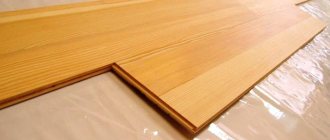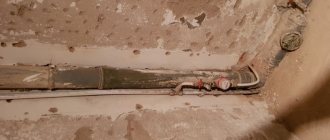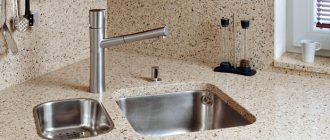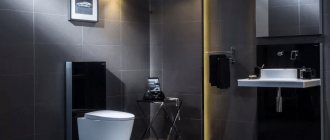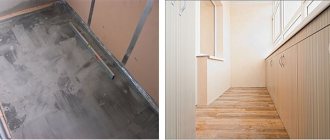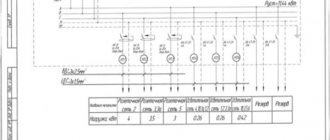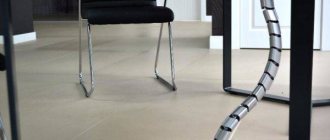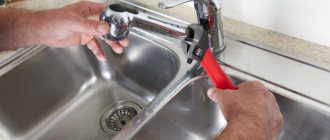Mosaic is an ancient method of creating patterns from small pieces of colored glass, ceramics and other materials. If earlier laying mosaics took a lot of time, since you had to select each piece of material and lay out the design, now, with the advent of mosaic tiles, it is possible to quickly finish the surface of the walls. Let's consider the advantages, types and methods of laying mosaics.
Spectacular mosaic tiles in the bathroom Source designm2.ru
The reason for the popularity of mosaics
Mosaic is a type of inlay that allows you to create amazingly beautiful images. Small multi-colored pieces of solid materials are arranged according to a pre-created sketch. There are two ways to perform a composition:
- direct set - mosaic elements are pressed into the ground;
- reverse set - the particles are placed face down on some kind of substrate, secured, the substrate is removed, and the seams are rubbed with adhesive.
To create mosaics, natural and artificial materials are used - glass, metal, enamel, pebbles, ceramics and others. When arranging the pieces, they lay out various patterns and drawings - thematic, folklore, geometric. People with creative abilities create real masterpieces of decorative art.
Laying mosaics on the wall is possible in any room with high humidity - in the bathroom, toilet.
Mosaic inserts look good in the kitchen interior Source pinimg.com
The pattern does not change color and does not deteriorate under the influence of steam or high temperature. Mosaic is easy to care for - the surface can be easily cleaned with a damp cloth and detergents. Mosaic finishing retains its original appearance for a long time, but when installed correctly.
Let's figure out how to put a mosaic on the wall so that it pleases the owners for many years.
Manually laying out patterns with small stones and glass takes a long time. To facilitate cladding, tesserae were created - square matrices with mosaic elements fixed on a grid. Mosaic tiles vary depending on the material:
- ceramic - have the same properties as tiles. It is characterized by high wear resistance, moisture resistance, strength, heat resistance, and ease of maintenance. May have a matte or glazed surface;
- glass - spectacular, but requiring careful selection of glue so that it does not shine through the material. They require complex care, as they are not resistant to aggressive environments and do not tolerate cleaning with abrasive agents;
Glass mosaic Source stroipark.com
- metal - made of aluminum or stainless steel. Mosaic looks unusual and is used to create exclusive interiors. Difficult to maintain and install;
- made of natural stone - expensive, allows you to create a luxurious design. Installation is carried out using ordinary glue or cement-sand mortar.
See also: Catalog of companies that specialize in finishing materials and related work
What features does the material have?
Porcelain tiles have the following features:
- It is durable, can be scratched, sanded, and cleaned. The matte finish will withstand everything except diamond.
- Porcelain tiles have no cracks or crevices.
- No risk of electric shock (if there is a washing machine or other electrical appliances in the bathroom).
- Does not react to aggressive chemicals, resistant to any detergents.
Subtleties of laying mosaics
Let's take a closer look at how to glue a mosaic on a wall. First of all, you need to prepare tools and materials:
- knife;
- grinder;
- glue;
- pencil;
- electric drill;
- bucket;
- grout;
- putty knife;
- mosaic tiles.
Laying includes the following steps:
- cleaning, priming, sanding, drying walls;
- surface marking - mark the layout of the tiles with a pencil;
- applying the adhesive composition to the wall and sheets with a spatula;
- mosaic installation - the tile is pressed to the surface with glue and pressed with a roller or spatula;
- removing the backing - run a wet sponge over the surface and remove the paper backing diagonally, pulling at the corner;
Removing the backing Source dizainvfoto.ru
- moisturizing and grouting;
- cleaning the tiles diagonally with a damp sponge;
- polishing with a dry cloth.
Advice for those who decide to do without professional help
It is better to start laying from the wall. There are adhesives that ensure virtually no slipping of the tiles, as they have increased adhesion.
Be sure to use a primer for better adhesion.
The tiles will look nicer if you use small crosses of 1.5 or 2 mm.
To prepare the adhesive mixture, first pour in the water, then the dry mixture, and not vice versa.Check it out here too!
How to make an arch from plasterboard: we make an interior arch according to photo instructions. 120 photos of arches in the interiorHow to make a balcony with your own hands - tips on how to make a balcony in an apartment beautiful. Step-by-step guide to the use of modern building materials + 70 photos of the best design options
Installing a compartment door with your own hands - step-by-step instructions for installing sliding doors and tips on choosing fittings (110 photos + video)
Use corners in internal and external corners.
When jointing seams, remove all excess immediately, without leaving it for later.
The working tool must be washed immediately, as it may not be washed later.
If you still have any questions, then it won’t hurt to watch the video of laying tiles in the bathroom with your own hands again. In it you can analyze all the stages in detail and see how the process happens from the outside.
Glue
Many people are interested in what to glue the mosaic onto so that it holds firmly. The adhesive composition must be carefully selected to match the properties of the wall surface, material, and operating conditions.
Special tile adhesive
The easiest way is to purchase a special adhesive for tiles at a building materials store, made on the basis of Portland cement with the addition of plasticizers. This is a ready-made composition that only requires dilution with water to the required thickness. The glue ensures reliable adhesion to any surface. This glue is not suitable for glass mosaics due to its light gray tint.
Tile adhesive Source purplemint.ru
Polymer glue
The acrylic-based mixture ensures reliable fixation of mosaics made of any materials on various surfaces. This is the best ready-made adhesive for rooms with humid air. Dyes are added to the composition, which makes it possible to use it to create interesting design solutions. Before use, stir and apply to the surface. The glue dries quickly, forming a glass-like mass.
Porcelain tiles and tiles, similarities and differences
These materials are identical in composition, the main difference lies in the technology. When producing porcelain tiles, dyes are immediately added to the main substances (no synthetic substances, only natural substances). Everything is mixed well and the desired tile shape is formed. It is pressed and baked under enormous pressure at high temperatures.
Clay becomes stronger than granite and marble. There are no pores in it, so the moisture resistance of porcelain stoneware is lower than that of brick.
The tile is a base coated with a glaze that can wear away over time, exposing the gray backing.
The choice of porcelain stoneware and tiles on the market is huge.
Nuances
Each type of mosaic tile requires compliance with certain gluing rules.
Let's look at how to glue mosaics on a grid.
The sheet is held with the front side facing you, and the back side is immersed in the adhesive Source colibrimosaic.ru
Gently press it against the wall with a roller or spatula so that the distance between the mosaic squares is the same. Remove any remaining glue and wait until it dries completely.
Recommendations
Knowing how to lay a mosaic correctly, listen to the advice of experienced craftsmen:
- do not press the sheets against the wall with your hands to avoid unevenness;
- to prevent the glue from drying out, the surface area should be no more than nine tiles;
- dilute the glue to a medium consistency, since a thick composition dries quickly, and a liquid one sticks;
- carry out installation at a temperature not exceeding +25 degrees;
- Apply mosaic adhesive on the mesh in a layer of no more than 3 mm, so that excess solution does not complicate the grouting.
Recommendations will help you avoid mistakes.
Mosaic masonry looks both solid and in combination with other materials. Source keram-market.ru
Briefly about the main thing
Mosaic tiles allow you to quickly and inexpensively tile the surface of any room. The variety of types makes it possible to choose the best option for different wall surfaces.
The basic requirements for creating a beautiful and durable mosaic are knowledge of what material the tiles are suitable for the room, and what glue to use to glue the mosaic.
Mosaic allows you to implement any design idea at low cost. The cladding looks impressive, and its properties are not inferior to ceramic tiles.
After studying the instructions on how to lay mosaic tiles, you can decorate a bathroom, toilet or other room yourself. It is important to adhere to the rules and recommendations for laying mosaic tiles.
Installation of tiles on the floor and walls
Before laying tiles on the floor, it is necessary to prepare the base so that you do not have to deal with alterations later. A perfectly flat floor surface is considered high quality. Any differences must be eliminated.
The best way to get a perfect surface is to arrange a leveling screed. Calculation of the thickness of the screed layer should take into account the thickness of the tile. As a result, after completion of work, opening and closing of interior and entrance doors should be free and not encounter obstacles.
Laying tiles on the floor with your own hands is a job carried out in several stages. Beginners in the business have to use various manuals and information contained on the Internet. Only later, having gotten the hang of it, as they say, they can do without tips, and before that, construction reference books and materials from construction sites become their assistants.
Particular interest is shown in the visual form of storytelling. Various videos and photos of do-it-yourself tile laying are popular. Such materials are viewed not only if you want to finish the floors, but also the walls.
As for the choice of wall surfaces as areas for cladding, the process of preparation for the main tiled covering looks similar to the floor.
The walls are cleared of old coatings and plastered to create an even layer for the tiles. Sometimes plaster seems useless and to obtain a smooth surface the walls are sheathed with sheets of plasterboard.
